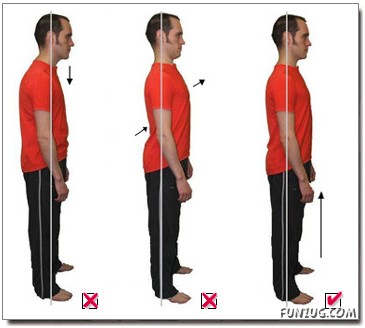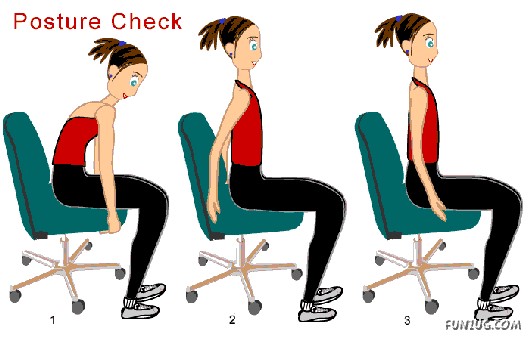Are you worried about looking like a hunchback? Here?s a pain free and effective method for safely assuming a ?correct? posture and improving muscle tone.
As a great side benefit, it would improve your self esteem and attitude! You will appear and feel more confident which improves your attitude and mood!

1. Know what good posture is believed to be. Most people think that to ?stand up straight? means tensing your back to heave your chest ?in and up?, and pulling your head back in to your chest. This is not so. The spine has two natural curves that you need to maintain called the ?double C? or ?S? curves, these are the curves found from the base of your head to your shoulders and the curve from the upper back to the base of the spine. When standing straight up, make sure that your weight is evenly distributed on your feet. You might feel like you are leaning forward, and look stupid, but you don?t.
2. Using a mirror, align your ears, shoulders, and hips. [This needs an image] Proper alignment places your ears loosely above your shoulders, above your hips. Again, these points make a straight line, but the spine itself curves in a slight ?S?. You?ll find that this doesn?t hurt at all. If you do experience pain, look at your side view in a mirror to see if you?re forcing your back into an unnatural position. If so, stop it!
3. Do exercises that strengthen the muscles across your upper back and shoulders. These do not have to be strenuous! Try the following, with or without hand weights:
* Align your ears over your shoulders. Raise both arms straight up, alongside your ears. Remember to keep your ears aligned! Bend forearms toward shoulders to touch your shoulder blades. Do 10 repetitions with both arms, then alternate 10 reps for each arm singularly.
* Align ears with shoulders.. Raise both arms out to sides at shoulder length. Hold for a slow count of ten. Slowly lower arms to sides, counting ten as you lower. Slowly raise arms back to shoulder height, counting to ten as you raise arms. Do ten reps, constantly checking your alignment! If ten reps are too many to start, do as many as you can. You should at least feel a slight fatigue in the shoulder muscles.
* Be a penguin. While you wait for a web page to load, toast to pop, or the microwave to beep, place elbows at your side, and touch your shoulders with your hands. Keeping your hands on your shoulders, and your ears aligned, raise both elbows (count one, two) and lower them back to your waist (count one, two). Do as many reps as your wait allows. You?ll be surprised how much exercise fits into 30 seconds.
4. Do stretches. This can greatly help if you find that you have a sore back or neck after a while.
* Tilt (stretch) your head in all four directions over your shoulders (forward, back, left, right), and gently massage your neck. Avoid rolling in a circle, as it may cause further strain.
* On your hands and knees, curl your back upwards, like a cat, and then the opposite. Think about being able to place a bowl in the hollow of your back.
5. Repeat the exercises a few times each day. Doing them in the morning helps your body stretch out the muscle lethargy of sleep, and periodically throughout the day helps raise your energy level without a heavy workout.
6. Doing yoga is also excellent for posture. You can take a class or find a good workout video.
Sitting
1. Sit in an office chair.
2. Align your back with the back of the office chair. Avoid slouching or leaning forward, especially when tired from sitting in the office chair for long periods. Keep your shoulders straight.
3. Flex your arms at a 75 to 90 degree angle at the elbows. You may have to adjust the office chair.
4. Make sure your neck, back, and heels are all aligned.
5. Keep both feet flat on the floor. If there?s a problem with feet reaching the floor comfortably, a footrest can be used along with the office chair.
Standing
1. Stand with weight mostly on the balls of the feet, not with weight on the heels. Avoid locking your knees.
2. Keep feet slightly apart, about shoulder-width.
3. Let arms hang naturally down the sides of the body.
4. Tuck the chin in a little to keep the head level. Be sure the head is square on top of the neck and spine, not pushed out forward
5. Stand straight and tall, with shoulders upright.
6. Stand against a wall with shoulders and bottom touching wall. In this position, the back of the head should also touch the wall ? if it does not, the head is carried too far forward (anterior head carriage).
Walking
1. Keep the head up and eyes looking straight ahead. Avoid pushing your head forward.
2. Keep shoulders properly aligned with the rest of the body.
Carrying Objects
1. Always bend at the knees, not the waist.
2. Use the large leg and stomach muscles for lifting, not the lower back.
3. If necessary, get a supportive belt to help maintain good posture while lifting.
4. When carrying a heavy or large object, keep it close to the chest.
5. If carrying something with one arm, switch arms frequently.
6. When carrying a backpack or purse, keep it as light as possible, and balance the weight on both sides as much as possible, or alternate from side to side.

Driving
1. Sit with the back firmly against the seat for proper back support. The seat should be a proper distance from the pedals and steering wheel to avoid leaning forward or reaching.
2. The headrest should support the middle of the head to keep it upright. Tilt the headrest forward if possible to make sure that the head-to-headrest distance is not more than four inches.
Sleeping
1. A relatively firm mattress is generally best for proper back support, although individual preference is very important.
2. Sleeping on the side or back is usually more comfortable for the back than sleeping on the stomach.
3. Use a pillow to provide proper support and alignment for the head and shoulders.
4. Consider putting a rolled-up towel under the neck and a pillow under the knees to better support the spine.
5. If sleeping on the side, a relatively flat pillow placed between the legs will help keep the spine aligned and straight.
A great side benefit of keeping your head straight, and your ears/shoulders/hips aligned is an improvement in your self-esteem and attitude. If you walk with your head up, you appear more confident, and feel more confident, which improves your attitude and mood, making it easier to walk with your head up.

